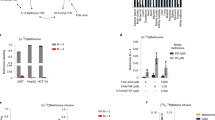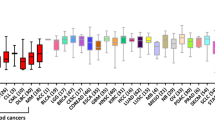Abstract
The metabolism of [2-14C]+[3', 5', 7, 9-3H] folic acid and [214C]+[3', 5', 7, 9-3H] 10-formylfolate was studied in hospital inpatients. Metabolites detected in the urine after folic acid feeding included the unchanged compound, other folates and a number of breakdown products, such as p-acetamidobenzoyl-L-glutamate and p-acetamidobenzoate. This confirms the existence of a folate catabolic pathway in man. Patients with malignant disease excreted less of the dose in urine, incorporated more into the reduced folate pool, and showed decreased catabolism of folate, when compared to controls. 10-Formylfolate was excreted largely unchanged, and appears not to be reduced by man. Also 10-formylfolate interfered with the reduction of folic acid given simultaneously.
This is a preview of subscription content, access via your institution
Access options
Subscribe to this journal
Receive 24 print issues and online access
$259.00 per year
only $10.79 per issue
Buy this article
- Purchase on Springer Link
- Instant access to full article PDF
Prices may be subject to local taxes which are calculated during checkout
Similar content being viewed by others
Rights and permissions
About this article
Cite this article
Saleh, A., Pheasant, A., Blair, J. et al. Folate metabolism in man: the effect of malignant disease. Br J Cancer 46, 346–353 (1982). https://doi.org/10.1038/bjc.1982.210
Issue Date:
DOI: https://doi.org/10.1038/bjc.1982.210
This article is cited by
-
Biochemistry and pharmacology of glycinamide ribonucleotide formyltransferase inhibitors: LY309887 and lometrexol
Investigational New Drugs (1996)
-
Malignant disease: nutritional implications of disease and treatment
Cancer and Metastasis Review (1987)
-
Acute folic acid deficiency after bone marrow transplantation
Klinische Wochenschrift (1986)



